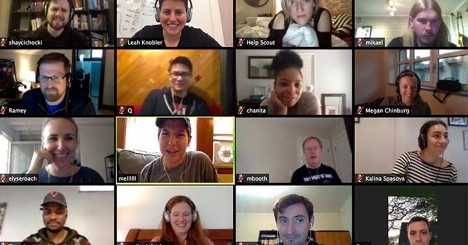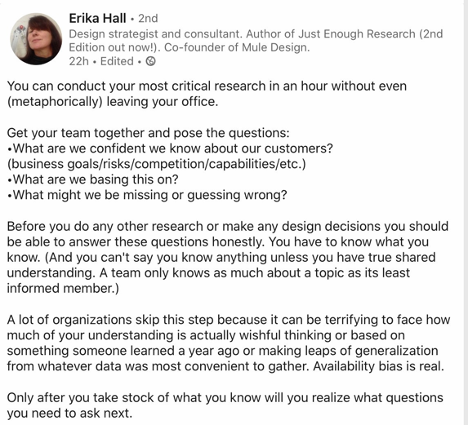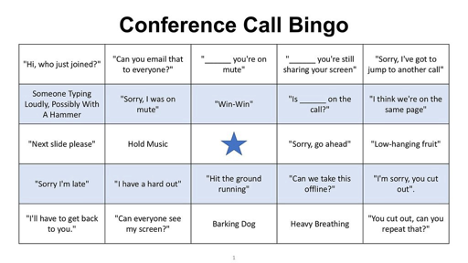Global pandemic or not, remote work is here to stay. For many organizations, the shift to distributed teams was sudden, one that did not have the benefit of planning or change management. This caused new anxieties and additional challenges with driving employee engagement, cultivating teamwork, and avoiding miscommunications.
Stumbles are inevitable and to be expected. The goal is two-fold:
Avoid turning bad incidents into negative patterns
Offset the negative with positive experiences at the rate of a 3-1 ratio (at the minimum).
In that spirit, here’s a list of generated and curated ideas for virtual team-building intended to contribute to the “upward spiral.” They not only increase engagement, but they can also get work done, drive learning and development, and dispense much-needed levity.
Disclaimer: All bets are off when kids are home. No one likes forced fun, so give parents the opportunity to opt out. They have a lot to juggle, so here’s a link from Red Tricycle, “Tips & Tricks For Working From Home (With the Kids).”
FOR GETTING WORK DONE
1. Work alone, together:
This episode of the Beyond 6 Seconds podcast is a reminder of the “working alone together” concept. In the past it was used to describe physical coworking spaces, but online gatherings have flourished to show that it can happen virtually as well. Anyone can host their own by simply getting on Zoom or Google Hangout with a few team members. No agenda needed, just an open line to enable happenstance conversations.
2. Host a brainstorming session:
Now’s a good time to consider posing some hard-to-solve challenges or questions that only connecting brilliant minds together can crack. A facilitated live group session using a tool like Mural or a thread in Slack (where people can contribute at their convenience) are both possible.
Just remember to create psychological safety with an open environment and apply the “no judgments” rule so creativity can abound.
This video has more tips on great brainstorming. Detailed instructions on how to set up a brainstorm can also be found in Culture Your Culture: Innovating Experiences @ Work on pages 111–119 in Chapter 6.
3. Crowdsource a mindmap:
Along the same lines, organize ideas, create structure around discussion topics/subtopics, and invite others to contribute to an online mind map.
Try bubbl.us, Mindmeister, or Mind Manager. Zapier also wrote about a few others.
4. Hold an Executive AMA:
There are mixed feelings about company Town Hall meetings under normal circumstances. However, companies need two-way communication with employees to ensure everyone gets important information at the same time and from the source.
E-mails aren’t enough, especially during uncertain times. Have leaders hold “Ask Me Anything” sessions to create an outlet and two-way communication platform. Partner with an experienced facilitator to ensure a productive conversation, one that doesn’t devolve into a “bitch session” and leaves people feeling better than when they began. Share FAQs, correct misinformation, and address fears — together.
5. Start a culture initiative:
Remote culture and work culture are the same. Stressful times reveal both good and bad cultures even more. Companies can’t afford bad culture as a liability. It must be addressed or else. And what better way to sustain a great culture than to actually create more great culture?
Many aspects of Design of Work Experience (DOWE), the step-by-step “how to” for culture can be done virtually, from employee user research (think consumer research but for employees), to co-design, planning, and implementation.
With the renewed interest and efforts around diversity, there’s a lot of culture work being done. Don’t be left behind.
If an entirely new culture project seems too daunting right now, consider the 30 Day Challenge instead. This simple, easy approach can be initiated by anyone at any level regardless of role.
6. Engage employees and build teams with open innovation:
Widespread adoption of online collaboration tools creates new possibilities for open innovation.
Go beyond the boundaries of the company, reconfigure teams internally and externally, and collaborate with customers and the outside community to innovate. As a departure from the norm, this could really inspire employees and recharge R&D. Host an appreciative inquiry summit or use another participatory design methodology to gather and explore new ideas.
7. Inspire with social impact:
A company’s social impact work is an opportunity to demonstrate their values externally. What could make employees more motivated and proud? This goes beyond sponsorship or donations--it involves everyone in civic engagement for the greater good. Take on a virtual design challenge like those seen on IDEO.org or learn from Ben & Jerry’s approach on corporate activism. Work with organizations like YWCA of Silicon Valley to honor women leaders while supporting essential services that fight poverty, domestic violence, and human trafficking.
FOR LEARNING & PROFESSIONAL DEVELOPMENT
8. Host an online Pecha Kucha :
This storytelling format is simple: “20 chosen images, each for 20 seconds. In other words, you’ve got 400 seconds to tell your story, with visuals guiding the way”.
With videoconferencing platforms aplenty, this can easily be moved online to share information and important narratives. This builds teams camaraderie and encourages learning.
9. Conduct Lunch and Learn webinars:
Turn lunchtime into designated “learn-time” by holding webinars that will impart new knowledge, provoke new thinking, and increase capabilities.
10. Have a fireside chat:
Interviewers and interviewees need not be in the same room. Pick an interesting topic, designate these two roles, and invite an audience to join. These can be recorded to share later.
11. Host a live podcast:
Companies are content creators too. Popular podcasters such as Jason Calacanis of This Week In Startups & Angel are known for not only releasing audio, but also video versions of their interviews online.
Do the same. It will engage employees and attract prospective employees as well.
FOR FUN
12. Keep or create book & tv/movie clubs:
These scratch the social connection itch for sure, but they are also great for developing knowledge.
Now that there is (theoretically) more bandwidth for this, check out this list of the best CX Books by eglobalis’ Ricardo Saltz Gulko (everyone has customers!) and NOVA’s TV watch list for startup founders.
13. Try improv games and exercises:
Nothing sparks creativity, out-of-the-box-thinking, and good vibes like improvisation. Doing improv together creates a shared experience, fosters trust, and brings people together.
Many can also be done online.
Letters to God described by Ted DesMaisons of Playful Mindfulness is a fun option to post on a slack discussion. Or pick other ideas from an entire book and website compiled by William Hall of Improv Games.
Vyve also hosts online celebrations and parties that encourage spontaneity. A group rendition of Whitney Houston’s “I Will Always Love You” has never been more fun. More of their ideas can be found here.
14. Create a viral video:
A fun project can bring a team together. There are lots of great examples of collaborative videos that went viral, but somatic movement coach Judith Lavender Dancer posted this one made by 42 choreographers. This proves that all teams of 42 or less can work together in this way.
15. Gather people just to connect:
Stanford professor and author Tina Seelig posted about online cocktail parties happening. If these are possible, so can the proverbial watercooler chat.
The isolation of working from home can be lonely for some. Gather in small groups just to shoot the breeze and watch the possibilities unfold. No need to make it formal or set expectations.
16. Create new channels/discussion groups by interest:
Start a new channel or group around a shared interest like cooking, movies, or sports in the company’s slack workspace. They will be welcome (and positive) respites throughout the workday and might actually improve productivity.
17. Offer opportunities for exercise:
Exercise instructors lost their main source of income without live classes. Many have shifted online and are available to get sedentary workers moving at home. Win-win.
18. Meditate as a group:
A guided meditation is a great way to collectively de-stress and re-center. There are other benefits too.
19. Play conference call bingo:
A company that can laugh at itself goes a long way with employees and lifts their spirits. There are certain meetings where this is inappropriate, but choose a few where people can have fun without needing to hide it.
20. Bring gamers together:
This post on LinkedIn’s Talent Blog shares a few ideas, but a favorite is about how CleverTech’s CEO Kuty Shalev “figured that playing online video games together would force employees who’d never met in person to collaborate to solve problems.”
Multiplayer, complex games that could be played online seem to work well. Maybe some new gamers might come out of it too.
Everyone could always use a little more morale. Hopefully more than a few ideas above prove useful.
Karen Jaw-Madson
Karen holds an MA in Social-Organizational Psychology and is an expert in organization and work culture. She is also the author of “Culture Your Culture: Innovating Experiences at Work”. She is the Founding Principal of Co.-Design of Work Experience.










